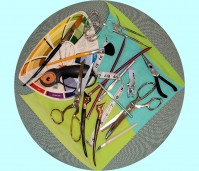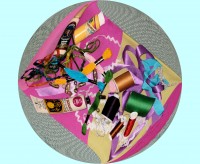 Sometimes the techniques we usually rely on may not suite a particular project or we just want to explore something else – something new and challenging. As artists of the 21st Century, we have unlimited resources to explore our creativity.
Sometimes the techniques we usually rely on may not suite a particular project or we just want to explore something else – something new and challenging. As artists of the 21st Century, we have unlimited resources to explore our creativity.
The prospect of learning something new might be a little daunting because it takes us out of our comfort zone, the familiar and safe. But a true creative spirit is always searching the cosmos for new experiences.
Want to Learn a new Technique? Begin by:
-
Assessing the knowledge and techniques that you already know, no matter how minimal the experience.
- Categorize this list by the types of media on which they can be used – some, like painting, will easily cross over to multiple mediums; embroidery not so much.
-
Give yourself an experience grade, beginner, intermediate, expert on each technique. Put a star next to the ones you enjoy the most, a circle next to the ones you want to explore more, and a dash next to the ones you feel are of little interest.
-
Make a list of new techniques you would like to explore.
-
Go back to your original list and determine if any skills or materials there can be used to jump start your new exploration. For instance, garment sewing is certainly a jump start for any machine sewing arts. Water color painting is a real boost for representational painting on fabrics.
-
Inventory your tools – scissors, paints, brushes, sewing machines, scroll saw, irons, needles etc. Every new technique requires new stuff. Do you already have most of what you need? If not, buy the best that you can afford. Good tools make your creative work go much easier. Keep them in good working order.
-
Research classes in your area or, if you can learn by reading, find good instructional books to start you on your way.
In a class, know that every student’s work will be unique and will never look just like the teacher’s. We all view our world differently so what we create is unique to us.
Most importantly JUMP IN AND GET GOING – LIFE IS TOO SHORT!
And remember, if you make a mistake it is only materials and time – not the end of life as we know it.
The Process
 Once you have decided what you are going to do and how, it is time to assemble all of your tools, materials, sketches and an open mind. An open mind is probably the most important tool you have because, things don’t always go as planned. Creative projects have a way of taking on a life of their own. If we are not prepared to go with the creative flow, we are setting ourselves up for disappointment.
Once you have decided what you are going to do and how, it is time to assemble all of your tools, materials, sketches and an open mind. An open mind is probably the most important tool you have because, things don’t always go as planned. Creative projects have a way of taking on a life of their own. If we are not prepared to go with the creative flow, we are setting ourselves up for disappointment.
Try to anticipate everything you will need and have it ready and easily accessible. Looking for a tool or material in the middle of creating can be disruptive. But, when the project decides that it needs to go in a different direction or needs something else, pause, listen, and get what it needs.
DON’T FORGET TO TAKE A BREAK NOW AND THEN. Walk away, eat, drink and come back with a fresh and critical eye. Re-evaluate your progress. Check design flow, colors and workmanship. Easier to correct now than when you think you are finished.
Know when you are finished and stop. Down the road you will probably look back at a piece and see areas where you could have done things differently. That means that you have matured as an artist and that you have brought your craft to a higher level. Resist the urge to make the changes – just smile and know that you have grown.
Above all, Have Fun !

